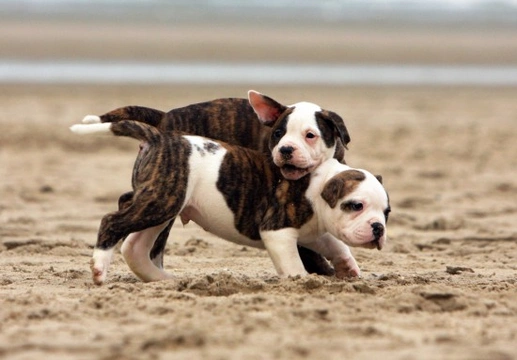
How to tell a play dog fight from a real fight
Dogs have a complex set of social cues that they use around each other when meeting and greeting, and as part of their interactions together even between dogs that are very familiar to each other. It is important that dogs are permitted to manifest their natural behaviours in social situations, and to follow the usual canine social interactions in order to form the basis of their relationship to each other without undue interference. Owners who are reluctant to let dogs get to grips with each other on their own terms are likely to greatly hamper the process of two dogs getting to know each other and getting on, and even introduce stress that can potentially lead to snapping and aggression.
However, if your dog is meeting other dogs at the dog park and they are growling, tussling or otherwise getting physical with each other, it is equally important to know when the time is right to step in if needed, in order to avoid a fight, or one of the dogs getting hurt.
A large part of this involves being able to tell the difference between play fighting and normal social interaction, and when two dogs are actually beginning to get aggressive and may be about to fight for real. Read on to learn how to tell the difference between play fighting and genuine fighting in canine social interactions.
Reading the small signals
Dogs will often display two contradictory behaviours at once, such as barking while wagging their tails, or growling while displaying their belly. Knowing how to interpret these small and often mixed signals will help you to identify the mood that the dogs are in, and what they are saying to each other through their actions.
Dogs enjoy play fighting, rough and tumble and mimicry of real fights just in the same way that humans like messing about, play-wrestling or taking the mickey out of each other. If two dogs are playing together and you hear growling, for instance, look to see if the growling is accompanied by bared teeth, a stiff posture and raised hackles, indicating aggression; or if is it accompanied by rolling around or bowing, which indicates play.
Role reversal
When dogs interact socially, there is a fairly strictly structured pack order of who is top dog and who is further down the food chain. However, playtime is an acceptable time for dogs to engage in a bit of role reversal, and again, within the normal parameters of acceptable behaviour, you might see the alpha dog permitting cheeky behaviour from the other dog, such as jumping at them, biting at them in play, or wrestling with them.
Chasing games often suddenly switch so that the initial dog is then pursuing, and these things can all happen rather quickly, which may make the pet owner think that one of the dogs has had enough and has lost their temper, but that is not the case. Open mouths, wagging tails, relaxed bodies and wriggling about all indicate acceptable play.
Self-limitation and bite inhibition
Any dog can inflict a nasty puncture wound by biting if they want to, which is something that you will not see in a genuine play fight. As part of play, dogs may appear to be biting each other’s legs, knocking each other around, and generally getting rough and ready! However, playing dogs will be actively displaying bite inhibition, grasping with their teeth but not biting down, and will set a ceiling to the limit of their rough behaviour that avoids either dog getting hurt. If one dog accidentally goes too far, the other one will stop the game, retreat, yelp or snap, and providing the other dog takes this cue to back off, the game is still afoot.
Signs of trouble
So, given that play-fighting is complex, often fast-moving and generally fairly rowdy, how can you tell if things are getting out of hand, and the meeting is about to turn sour or escalate into a real fight?
Look out for overly dominant behaviour, and one dog not backing off when the other gives the signals to stop. Play-biting that elicits growls or yelping should be a cue for the biter to stop, and games of chase should end when one dog stops running or engaging with the other dog. Staring at each other while growling with bared teeth and a stiff posture is another warning sign, and one dog constantly putting the other one down onto the ground, pushing them down with their paws or knocking them over once the other dog shows signs of retreat is yet another.
While it is important not to intervene into play and disrupt the relationship forming between two dogs, you should also be alert to these warning signals, and know when to cut the game short and recall the dogs in question, before things get out of hand.



